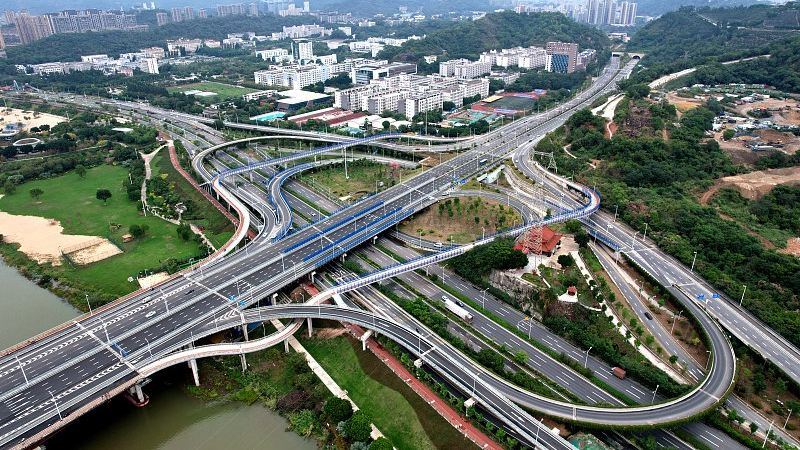
A newly opened viaduct in Fuzhou, China's Fujian Province, November 24, 2022. /CFP
A newly opened viaduct in Fuzhou, China's Fujian Province, November 24, 2022. /CFP
Editor's note: Liu Chunsheng is an associate professor at the Beijing-based Central University of Finance and Economics. The article reflects the author's opinion, and not necessarily the views of CGTN.
On March 3, 2023, China's State Council Information Office held a press conference on supporting the high-quality development of real economy.
In 2022, China's economic growth reached 3 percent, lower than the target set in 2022 "Two Sessions." The tune for 2023 in China is to make every effort for economic development.
China has announced plans to promote its real economy by providing financial support in 2023. This move is expected to address some of the challenges facing small and micro enterprises, which have struggled with financial constraints in recent years.
Financial constraints have been a significant issue for the real economy in China, particularly for small and micro enterprises. These companies often lack the financial strength and credit history to obtain traditional bank loans, which limits their ability to grow and expand. This is a problem that has been compounded by the economic impact of the COVID-19 pandemic, which has left many businesses struggling to stay afloat.
To address this issue, the Chinese government has announced plans to provide financial support to the real economy in 2023. This includes measures to promote lending to small and micro enterprises, as well as other initiatives aimed at supporting economic growth and development.
One of the key components of this plan is to provide low-interest loans to small and micro enterprises. These loans will be provided through government-backed lending programs, which will make it easier for these companies to access the financing they need to grow and expand. Additionally, the government will encourage financial institutions to provide more support to these companies by offering tax incentives and other benefits.
Another key element of the plan is to promote the development of internet finance. This includes initiatives to expand digital payment systems and other online financial services, which will make it easier for small and micro enterprises to access financing and manage their finances more efficiently. This is a critical area for growth in the Chinese economy, as more and more consumers and businesses are turning to digital channels for their financial needs.
In addition to these measures, the Chinese government will also promote the development of the real economy through a range of other initiatives. This includes support for key industries such as manufacturing, technology, and infrastructure, as well as measures to promote entrepreneurship and innovation.
Since 2022, the People's Bank of China has issued multiple structural monetary policy tools to guide financial institutions to reasonably allocate loans around key areas and weak links in the national economy, such as inclusive finance, green development, and technological innovation.
The "soft power" of enterprises has become a "hard currency" for financing, and financial liquidity is flowing continuously into innovative enterprises, effectively solving long-standing difficulties in financing for technology innovation-oriented small and medium-sized enterprises, such as difficulty in obtaining financing, high financing costs, and slow process.

Consumers shop for fruit at a supermarket in Luoyang, Henan Province, February 28, 2023. /CFP
Consumers shop for fruit at a supermarket in Luoyang, Henan Province, February 28, 2023. /CFP
Financial institutions are exploring more effective financing models to support the development of technology innovation-oriented small- and medium-sized enterprises and further promote economic transformation and upgrading.
Overall, the Chinese government's plan to promote the real economy through financial support is a positive step forward for the country. By addressing the challenges facing small and micro enterprises, this plan has the potential to drive economic growth and development in the years to come.
However, there are also risks associated with this plan. One of the key concerns is that providing too much financial support could lead to a rise in debt levels and other financial imbalances. This could ultimately undermine economic stability and lead to a range of other problems in the future.
To mitigate these risks, China will need to implement careful and strategic measures, including ensuring that lending is done responsibly and with appropriate risk management measures in place.
Another key challenge will be to ensure that the benefits of this plan are shared equally across the economy. While small and micro enterprises are a critical area of focus, it is important to ensure that larger companies and other parts of the economy also benefit from these initiatives. This will require careful planning and coordination, as well as a commitment to promoting inclusive and sustainable economic growth.
(If you want to contribute and have specific expertise, please contact us at opinions@cgtn.com. Follow @thouse_opinions on Twitter to discover the latest commentaries in the CGTN Opinion Section.)